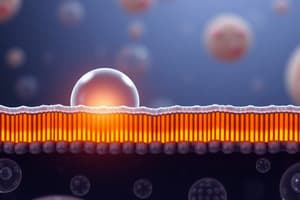Podcast
Questions and Answers
What property of phospholipids allows them to spontaneously arrange into bilayers in aqueous environments?
What property of phospholipids allows them to spontaneously arrange into bilayers in aqueous environments?
- They are entirely hydrophobic
- They are non-polar and repel water
- They are entirely hydrophilic
- They are amphipathic, having both hydrophilic and hydrophobic regions (correct)
Integral proteins are found only on the surface of the cell membrane.
Integral proteins are found only on the surface of the cell membrane.
False (B)
How do glycoproteins and glycolipids contribute to cell communication?
How do glycoproteins and glycolipids contribute to cell communication?
Cell Recognition and Adhesion
___________ are specialized channel proteins that facilitate rapid water transport across the cell membrane.
___________ are specialized channel proteins that facilitate rapid water transport across the cell membrane.
Match the following types of solutions with their effect on cells:
Match the following types of solutions with their effect on cells:
What is the primary function of stem cell niches in adult humans?
What is the primary function of stem cell niches in adult humans?
Water always moves from areas of lower water potential to areas of higher water potential.
Water always moves from areas of lower water potential to areas of higher water potential.
Define cell differentiation.
Define cell differentiation.
According to the fluid mosaic model, the cell membrane is described as a ________ structure with proteins and lipids moving laterally within the bilayer.
According to the fluid mosaic model, the cell membrane is described as a ________ structure with proteins and lipids moving laterally within the bilayer.
Which of the following is a key advantage of compartmentalization in eukaryotic cells?
Which of the following is a key advantage of compartmentalization in eukaryotic cells?
Flashcards
Phospholipids
Phospholipids
Molecules with hydrophilic heads and hydrophobic tails that form bilayers in aqueous environments, creating cell membranes.
Selective Permeability
Selective Permeability
The hydrophobic core of the lipid bilayer prevents large, polar molecules and ions from easily passing through.
Gaseous Exchange
Gaseous Exchange
Small, non-polar molecules diffuse directly across the phospholipid bilayer without needing transport proteins.
Integral Proteins
Integral Proteins
Signup and view all the flashcards
Peripheral Proteins
Peripheral Proteins
Signup and view all the flashcards
Aquaporins
Aquaporins
Signup and view all the flashcards
Selective Permeability (via Channels)
Selective Permeability (via Channels)
Signup and view all the flashcards
Energy-Dependent Transport
Energy-Dependent Transport
Signup and view all the flashcards
Cell Recognition and Adhesion
Cell Recognition and Adhesion
Signup and view all the flashcards
Osmosis
Osmosis
Signup and view all the flashcards
Study Notes
Membranes and Membrane Transport
- Lipid and protein molecules assemble into biological membranes.
- A substance's ability to pass through a biological membrane is determined by characteristics like size, charge, and solubility.
Lipid Bilayers as the Basis of Cell Membranes
- Phospholipids are amphipathic, containing hydrophilic heads and hydrophobic tails.
- In aqueous environments, phospholipids form bilayers, creating the basic structure of cell membranes.
Lipid Bilayers as Barriers
- Lipid bilayers act as selective permeability barriers.
- Hydrophobic cores prevent large molecules, hydrophilic particles, ions, and polar molecules from crossing.
- Membranes effectively separate aqueous environments inside and outside the cell.
Simple Diffusion Across Membranes
- Small, non-polar molecules like oxygen (O2) and carbon dioxide (CO2) diffuse directly across phospholipid bilayers.
- This diffusion occurs without the need for transport proteins.
Integral and Peripheral Proteins in Membranes
- Integral proteins are embedded within the lipid bilayer, spanning the membrane.
- Integral proteins function as channels or transporters.
- Peripheral proteins attach to the membrane surface, playing a role in signaling and maintaining cell shape.
Movement of Water Molecules Across Membranes by Osmosis and the Role of Aquaporins
- Osmosis involves water moving across membranes from lower to higher solute concentrations.
- Aquaporins are specialized channel proteins that facilitate rapid water transport.
- Aquaporins are crucial in cells requiring high water permeability.
Channel Proteins for Facilitated Diffusion
- Channel proteins allow specific ions or molecules to pass through membranes.
- This process occurs by facilitated diffusion, which allows selective permeability.
Pump Proteins for Active Transport
- Pump proteins use energy from ATP to move specific particles across membranes.
- This movement occurs against the concentration gradient.
- This process is known as active transport.
Selectivity in Membrane Permeability
- Facilitated diffusion and active transport enable selective permeability.
- These mechanisms allow cells to regulate their internal environment.
Structure and Function of Glycoproteins and Glycolipids
- Glycoproteins and glycolipids have carbohydrate chains on the extracellular side of membranes.
- These structures play roles in cell recognition and adhesion.
Fluid Mosaic Model of Membrane Structure
- The fluid mosaic model describes the membrane as a dynamic structure.
- Proteins and lipids move laterally within the bilayer.
Organelles and Compartmentalization
- Organelles in cells are adapted to their specific functions through their structure.
- Compartmentalization in cells offers advantages, such as increased efficiency by concentrating resources.
Organelles as Discrete Subunits of Cells Adapted to Specific Functions
- Organelles are specialized structures within cells that perform distinct functions.
- The nucleus, mitochondria, endoplasmic reticulum, and Golgi apparatus are examples of organelles.
Advantage of the Separation of the Nucleus and Cytoplasm into Separate Compartments
- In eukaryotes, the separation between the nucleus and cytoplasm allows for post-transcriptional modifications before translation.
- This separation enhances gene expression regulation.
Advantages of Compartmentalization in the Cytoplasm of Cells
- Compartmentalization allows for the concentration of metabolites and enzymes.
- The concentration of material enhances metabolic efficiency.
Cell Specialization and Stem Cells
- Stem cells play key roles in multicellular organisms, including development and repair.
- Differentiated cells are adapted to their specialized functions through specific structures and activities.
Production of Unspecialized Cells Following Fertilization and Their Development into Specialized Cells by Differentiation
- Following fertilization, cells undergo differentiation, leading to specialized cell types with distinct functions.
- Cell differentiation is vital for forming complex tissues and organs.
Properties of Stem Cells
- Stem cells can divide indefinitely and differentiate into various cell types.
- A stem cell's differentiation depends on its potency.
Location and Function of Stem Cell Niches in Adult Humans
- Specific microenvironments, such as bone marrow and hair follicles, maintain stem cells.
- These microenvironment niches regulate stem cell proliferation and differentiation.
Differences Between Totipotent, Pluripotent, and Multipotent Stem Cells
- Totipotent cells can form all cell types.
- Pluripotent cells can form most but not extra-embryonic tissues.
- Multipotent cells are limited to specific lineages.
Cell Size as an Aspect of Specialization
- Cell size varies depending on function.
- Neurons, red blood cells, and muscle fibers showcase cell size variation.
Surface Area-to-Volume Ratios and Constraints on Cell Size
- A larger surface area-to-volume ratio facilitates efficient exchange of materials.
- The surface area-to-volume ratio influences cell size limitations.
Water Potential (Ψ)
- Water potential measures the potential energy of water in a system.
- Water potential helps determine the direction of water movement.
- Water potential is influenced by solute concentration and pressure.
- Water potential is represented by Ψ (psi) and measured in megapascals (MPa).
- Pure water at standard conditions has a water potential of zero.
- The overall water potential equation is: Ψ = Ψ_s + Ψ_p
- Water moves from regions of higher (less negative) to lower (more negative) water potential, which is influenced by the surrounding solution's tonicity.
Components of Water Potential
- Solute potential (Ψ_s) or osmotic potential accounts for the effect of dissolved solutes on water potential.
- The presence of solutes lowers the water potential, making it more negative.
- Pressure potential (Ψ_p) refers to the physical pressure exerted on or by the water within a system.
- Turgor pressure in plant cells is an example of pressure potential.
- In plant cells, turgor pressure contributes positively to pressure potential.
- By the plasma membrane of the cell wall, turgor pressure maintains cell rigidity and structural integrity.
Water Movement in Cells
- Hypotonic solutions have higher water potential/lower solute concentration than the cell.
- This may cause animal cells swell/burst or increase in plant cells.
- Hypertonic solutions have lower water potential/higher solute concentration than the cell.
- This may cause animal cells shrivel or plant cell membranes pull away from cell wall.
- Isotonic solutions have the same water potential as the cell's environment.
- Water movement is not impacted and the cell maintains its shape.
Importance in Plants
- Water potential is crucial for understanding water movement in plants.
- Water potential is important in processes like nutrient uptake and turgor pressure maintenance.
- Turgor pressure is vital for structural support and growth in plants.
Studying That Suits You
Use AI to generate personalized quizzes and flashcards to suit your learning preferences.





